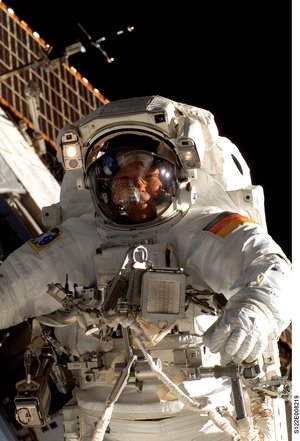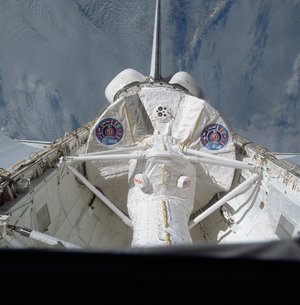Spacelab D-2
MISSION STATISTICS
Mission name: STS-55
Shuttle: Columbia
Number of crew members: 7
Launch:
26 April 1993, 10:50 a.m. EDT
Landing:
6 May 1993, 10:30 a.m. EDT, Edwards AFB Runway 22
Duration: 9 days, 23 hours, 39 minutes, 59 seconds
Number of orbits: 148
CREW
- Steven R. Nagel (4), Commander
- Terence T. Henricks (2), Pilot
- Jerry L. Ross (4), Mission Specialist 1
- Charles J. Precourt (1), Mission Specialist 2
- Bernard A. Harris Jr. (1), Mission Specialist 3
- Ulrich Walter (1), Payload Specialist 1 - Germany
- Hans Schlegel (1), Payload Specialist 2 - Germany
(1) number of spaceflights each crew member has completed, including this mission

MISSION HIGHLIGHTS
Columbia was initially scheduled to launch 22 March 1993, but a computer-controlled pad abort triggered after the main engines had ignited, at only T-3 seconds. The abort was caused by suspicion that tip-seal retainers in the main engines' turbopumps might be worn, but later inspection revealed the retainers to be in good condition. The actual launch was at 10:50 a.m. EDT on 26 April 1993.
Columbia carried to orbit the second reusable German Spacelab on the STS-55 mission and demonstrated the shuttle's ability for international cooperation, exploration, and scientific research in space. The Spacelab Module and an exterior experiment support structure contained in Columbia’s payload bay comprised the Spacelab D-2 payload. (The first German Spacelab flight, D-1, flew Shuttle mission 61-A in October 1985.) The U.S. and Germany gained valuable experience for future space station operations.
The D-2 mission, as it was commonly called, augmented the German microgravity research program started by the D-1 mission. The German Aerospace Research Establishment (DLR) had been tasked by the German Space Agency (DARA) to conduct the second mission. DLR, NASA, the European Space Agency (ESA), and agencies in France and Japan contributed to D-2's scientific program. Eleven nations participated in the experiments. Of the 88 experiments conducted on the D-2 mission, four were sponsored by NASA.
The crew worked in two shifts around-the-clock to complete investigations into the areas of fluid physics, materials sciences, life sciences, biological sciences, technology, Earth observations, atmospheric physics, and astronomy. Many of the experiments advanced the research of the D-1 mission by conducting similar tests, using upgraded processing hardware, or implementing methods that take full advantage of the technical advancements since 1985. The D-2 mission also contained several new experiments which were not previously flown on the D-1 mission.
The D-2 Mission conducted 88 experiments to study life sciences, material sciences, technology applications, Earth observations, astronomy, and atmospheric physics. It surpassed the 365th day in space for the Space Shuttle fleet and the 100th day of flight time in space for Columbia, the fleet's oldest Orbiter on its fourteenth flight.
D-2 marked the first tele-robotic capture of a free floating object by flight controllers in Germany. The crew conducted the first intervenus saline solution injection in space as part of an experiment to study the human body's response to direct fluid replacement as a countermeasure for amounts lost during space flight. They also successfully completed an in-flight maintenance procedure for collection of orbiter waste water, which allowed the mission to continue.
STS-55 crewmembers participated in two amateur radio experiments, SAREX II from the United States and the German SAFEX. These experiments allowed students and amateur radio operators from around the world to talk directly with the Space Shuttle in orbit and participated in a Space Medicine conference with the Mayo Clinic.







